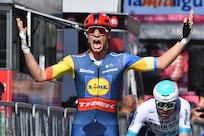Anyone who has visited the Saadiyat Island exhibition at the Emirates Palace in Abu Dhabi will have gaped, open-mouthed at the scale and audacity of the plans for the island's development. Golf courses, marinas and hotels are all there. But it is the Cultural District, with its four world-class museums, that really gets the pulse racing. The Guggenheim Abu Dhabi, the Louvre Abu Dhabi, the Sheikh Zayed National Museum and the Maritime Museum are all in the advanced planning stages, with the Louvre scheduled for completion in 2012. Their avant-garde design, momentous scale and priceless international collections will no doubt be a significant tourist attraction. The Tourism Development and Investment Company (TDIC), whose job it is to turn these visions into reality, also has another role: prepping a home-grown audience for whom access to international works of art has so far been limited.
Luckily, they have a plan, and Artscape Picasso, an interactive art event linked to the artist's recent exhibition at the Emirates Palace and the first in a planned series of informal cultural events aimed at engaging the public in the run-up to 2012, took place at the Cultural Foundation last month. "It's a very diverse programme," says Mahita El Bacha Urieta, public programming manager at TDIC, "which includes Artscape, as well as lectures and workshops, like the one we held recently with the artist and photographer Jacob Sutton. Some things are very hands-on and others are more general. Some will be more like lifestyle events but with culture at the centre of them."
For Artscape Picasso, the first floor of the Cultural Foundation was transformed into a vibrant, multi-sensory experience around a Picasso theme. A painting studio gave people a chance to flex their artistic muscles; a live band played a fusion of Spanish and Middle Eastern guitar music; and a sand animator staged a performance in the lobby. There was also a documentary on Picasso, which featured a collection of archive material, as well as a talk on "Why Modern Art?" by Dr Martin Giesen, an artist and a professor of art history in the visual and performing arts at the American University of Sharjah. "The idea is to have different art forms around one theme, happening semi-simultaneously, so it's a really thick, intense experience for everyone," says Urieta. "This event is about entertainment and what I call passive education; you don't realise you're actually absorbing a lot. It's a very different attitude to an education programme where you're sitting people down and lecturing them."
Furnishing the Cultural District's museums will generate an unusual set of circumstances, whereby international works of art and artefacts from many periods arrive within a relatively short time frame, in a country that, until recently, has had little museum culture. Abu Dhabi's partnership with the Louvre alone will allow collections from the Centre Georges Pompidou, Musée d'Orsay, Versailles and the Louvre in Paris to be exhibited in Abu Dhabi for the first time. "For people who have grown up in Europe," says Giesen, "where there are many famous museums to visit, we have benefited from the fact that our imperial and colonial forebears collected works from around the world for our benefit. They are bringing big imported exhibitions here now, which is fabulous."
"The Sheikh Zayed National Museum (being designed by Lord Norman Foster) is the first of its kind to be built in the UAE," says Urieta, "so that requires a certain awareness and information about what it is. We're just here to frame that; to create these institutions and show them to the world." The impressive turnout at Artscape Picasso was an early affirmation of the public's interest in "accessible art". "We completely underestimated the amount of painting supplies we would need and the hunger for it," said Urieta, speaking at Artscape. "There's a great civic atmosphere. It's an activation of the Abu Dhabi community in all its variety: the range of classes, ages, races, genders - people are all coming together. It's part of the bigger picture for Abu Dhabi that we want to create."
TDIC's public programmes agenda links to Abu Dhabi's wider strategy to turn the emirate into a cultural hub for the region. "There may be a Picasso exhibition or high-profile exhibition on ceramics," says Urieta, "and people know it's important because everyone's making a fuss about it, but they don't really feel it unless they come from the art world. The purpose of public programmes is to fill that gap, to draw people in."
However, the crowd at Artscape Picasso, though multinational, was heavily balanced in favour of expatriates, which raises the question whether these kinds of events are likely to engage all areas of the population. "I saw practically no local college students, which is a sad situation," says Giesen. "Just bringing the Picasso exhibition to Abu Dhabi is not going to suddenly turn the interest of the young generation. What is needed is very basic work, starting in kindergarten and continuing through elementary and secondary schools. And Abu Dhabi is trying that, which is marvellous."
"TDIC are developing something at the moment which is particularly focused on education," Urieta tells me. "For both the Arts of Islam and Picasso exhibitions, we had dedicated tours and an education programme for schools, with guided tours on site to encourage the children to engage with and understand what they were looking at. We're going to be doing more and more of this." At a time when the rest of the world is battening down the hatches in the maelstrom of the credit crisis, Abu Dhabi's ambitious plans continue apace. And there is a lot to do. "Anyone who can provide or contribute something for the cultural agenda, is doing so. Our focus is very much towards the museum development, because as you can imagine with the scale of the projects, a lot of work needs to be done before 2012."
Fortunately, as a result of the phenomenal response to Artscape Picasso, a second event is being planned for December, and this audience is primed and ready. As Urieta says, "It becomes relevant to people when they are sitting in the centre enjoying what's going on, wanting to be there and to pick up a brush and do something. It's all very well having these wonderful museums, but if there's nobody to enjoy them, they would be like beautiful shells."
kboucher@thenational.ae





